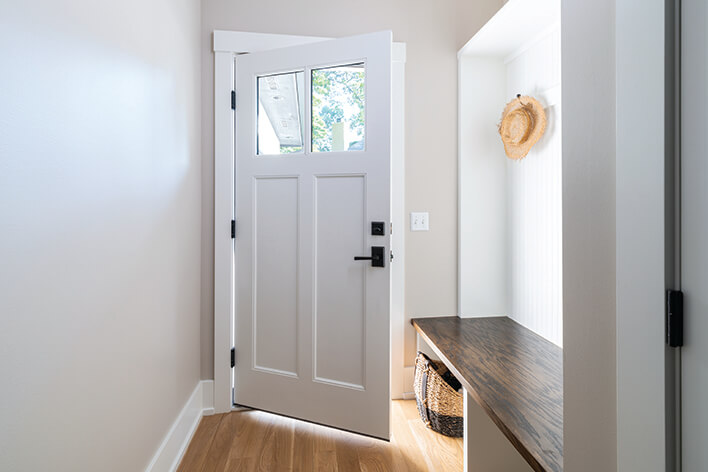What Does ENERGY STAR Compliance Mean for You and Your Home?

How ENERGY STAR windows and doors help your home and the planet.
What has five points and lets the world know you’re a consumer who’s both smart and ethical?
The ENERGY STAR!
But not many people know how the ENERGY STAR came to be or exactly how home products and appliances earn their ENERGY STAR labels.
What does ENERGY STAR-certified mean?
Most energy sources pollute, harm the climate, and impact our health. So, we help keep the world cleaner and healthier when we use less energy.
The ENERGY STAR symbol was established in 1992 by the U.S. Environmental Protection Agency (EPA) as part of a voluntary labeling program to promote energy-efficient products and reduce greenhouse gas emissions.
Back in those days, the first use of the label was on computers and monitors. By 1995, the program expanded to include office equipment and residential heating and cooling systems. After the EPA began a partnership with the Department of Energy, the ENERGY STAR grew to more than 70 product categories, including major appliances, lighting, electronics, and residential and commercial building materials.
So, how does the EPA select ENERGY STAR products?

Well, the answer’s a little complicated, but this video is a great place to start.
There’s a lot of testing and consideration required to earn a strong ENERGY STAR rating. But the whole point of this very successful system is to provide consumers with an unbiased and easily recognized point of confidence for selecting energy-efficient products.
The brilliance is its simplicity. Behind every ENERGY STAR label is a multitude of resources from the EPA and the Department of Energy to help you research new and better ways to save energy in your home and at work.
How climate affects ENERGY STAR ratings
Naturally, windows and doors designed for hot climates, such as Florida or Texas, need different qualities than those used in Minnesota or North Dakota. For instance, you don’t want your double-hung window trapping heat if you live in a warm area. And you wouldn’t want a sliding glass patio door that lets cool air into your home during the winter months up North.
Therefore, the experts at ENERGY STAR divided the U.S. into four zones:
- Northern
- North-Central
- South-Central
- Southern
These zones are based on variables such as climate and temperature fluctuations, humidity, and rain.
It’s wise when buying ENERGY STAR-rated exterior home products like windows and doors to check that they are rated for your climate zone.
ENERGY STAR window ratings

The ENERGY STAR label uses thermal test results from the National Fenestration Rating Council (NFRC) to help consumers compare window performance through various ratings. This is based on the U-Factor, which measures the rate of heat transfer (how much heat is lost or gained through your window), solar heat gain coefficient (SHGC), air leakage, visible transmittance, and condensation resistance.
According to ENERGY STAR, the U-Value of a window can range from .25 to 1.25. The lower the U-Value, the more energy-efficient your window is. If your home’s windows face the sun, installing replacement windows with a lower U-Value is even more important.
ENERGY STAR door ratings

Entry doors are any exterior door that leads from outside to inside, such as patio doors and front doors. For these doors, energy efficiency is greatly associated with the window surface within the door.
A solid steel, vinyl, or fiberglass door will give you the best efficiency ratings. Sliding patio doors, which are basically big windows, can be ranked the same way as ENERGY STAR windows. Another factor to consider with entry doors is sidelites and transom windows. Make sure these also carry the ENERGY STAR rating when making selections for your home.
What does ENERGY STAR certified mean for you and your home?
The ENERGY STAR certification makes life easier when you want to buy something for your home. When it comes to interior and exterior home remodeling, ENERGY STAR doors and windows assure you of five things:
- You’ll see lower energy bills.
- You’ll save energy and reduce greenhouse gas emissions.
- You and your home will be more comfortable with fewer drafts and more consistent temperatures.
- Your home will be protected from UV damage to floors and furnishings thanks to low-emissivity coatings.
- You’ll have peace of mind knowing your doors and windows are certified and verified to perform as labeled.
Window World is an ENERGY STAR partner, which means we put innovation to work, developing intelligent solutions that improve the lives of people and the health of our planet. We offer a variety of window and door packages that are ENERGY STAR-certified. Drop by your local Window World store and find out more about how these products can transform the home you love. It all starts with a free consultation and quote. Find the Window World store near you today.

